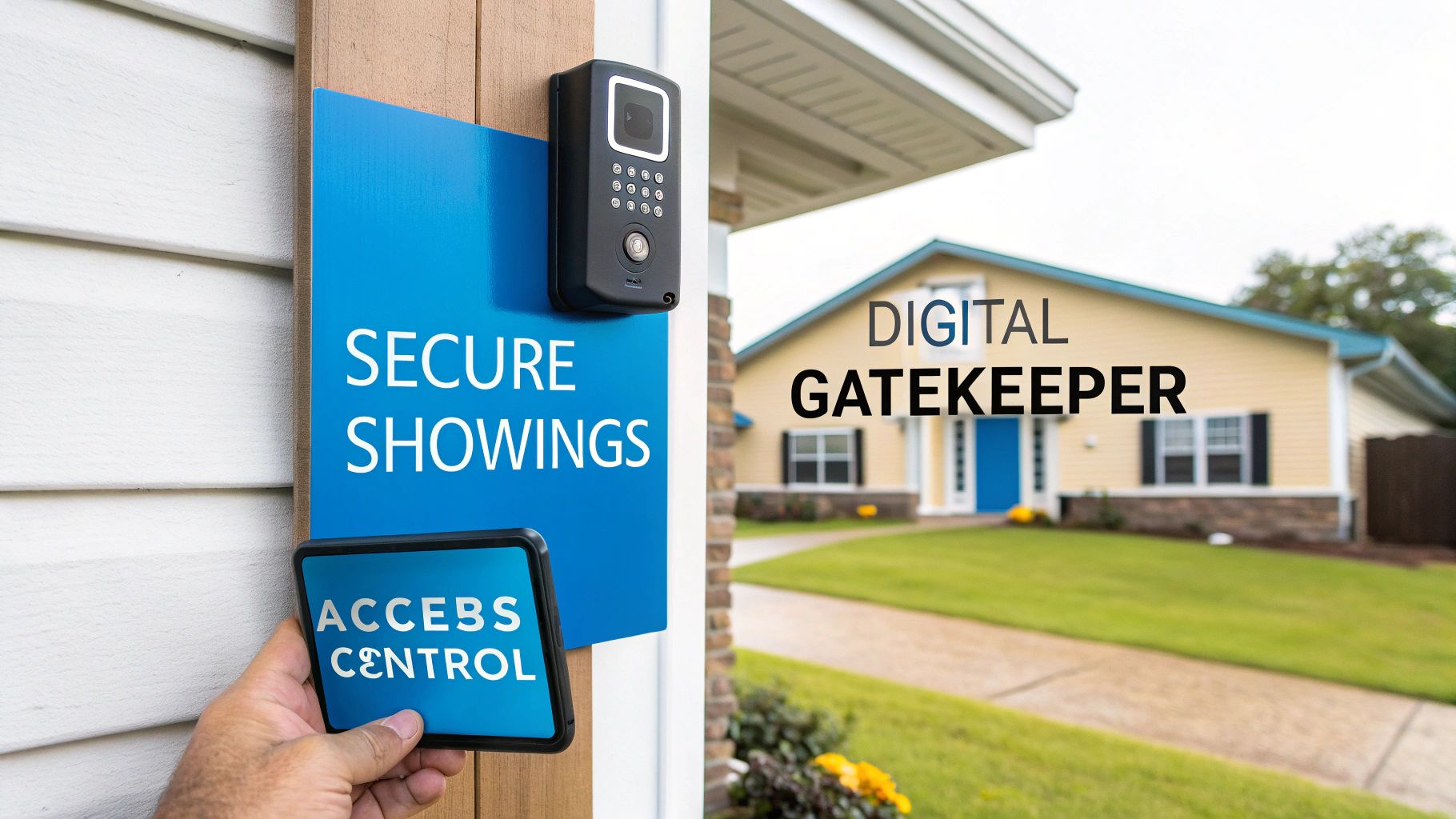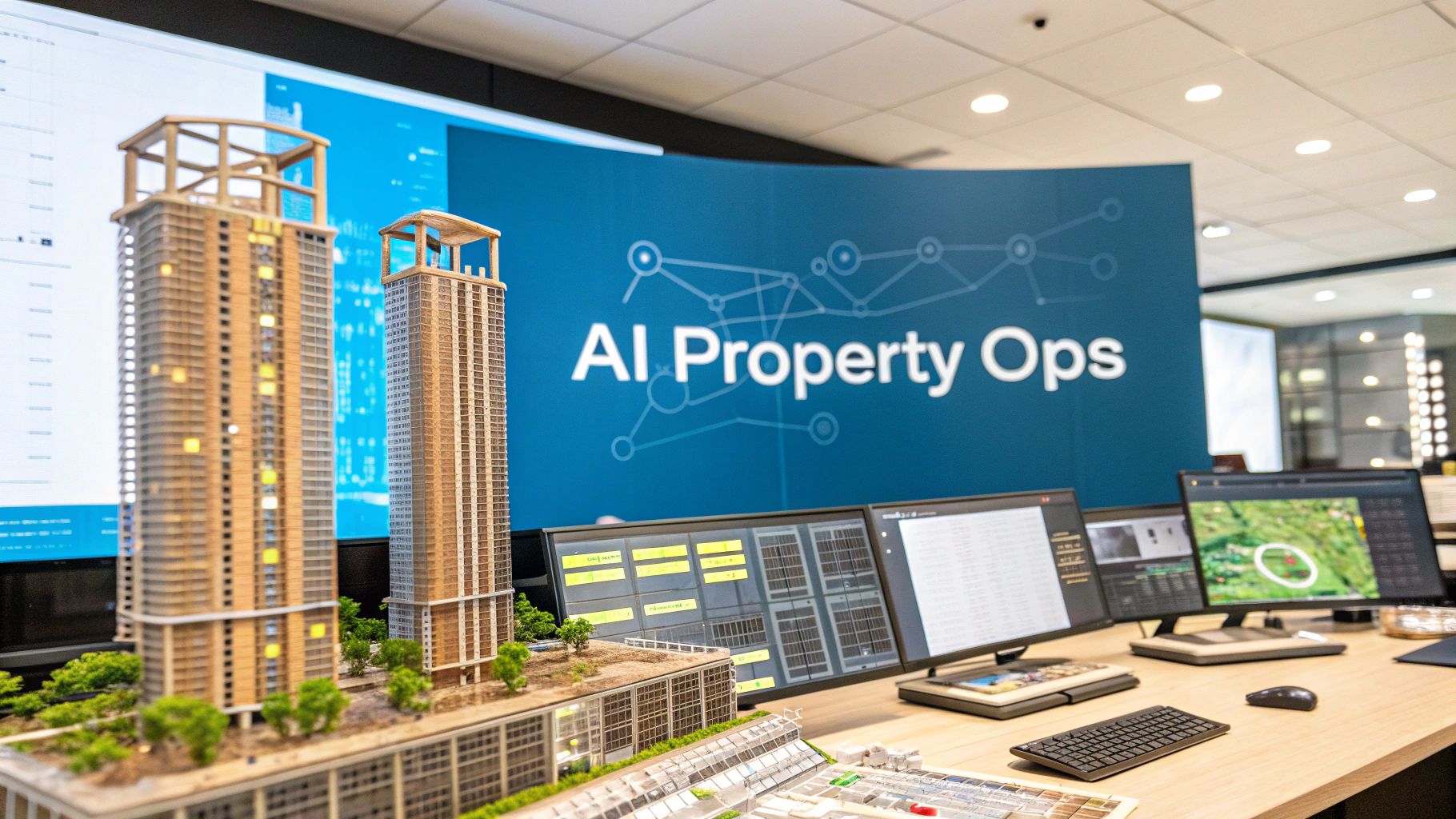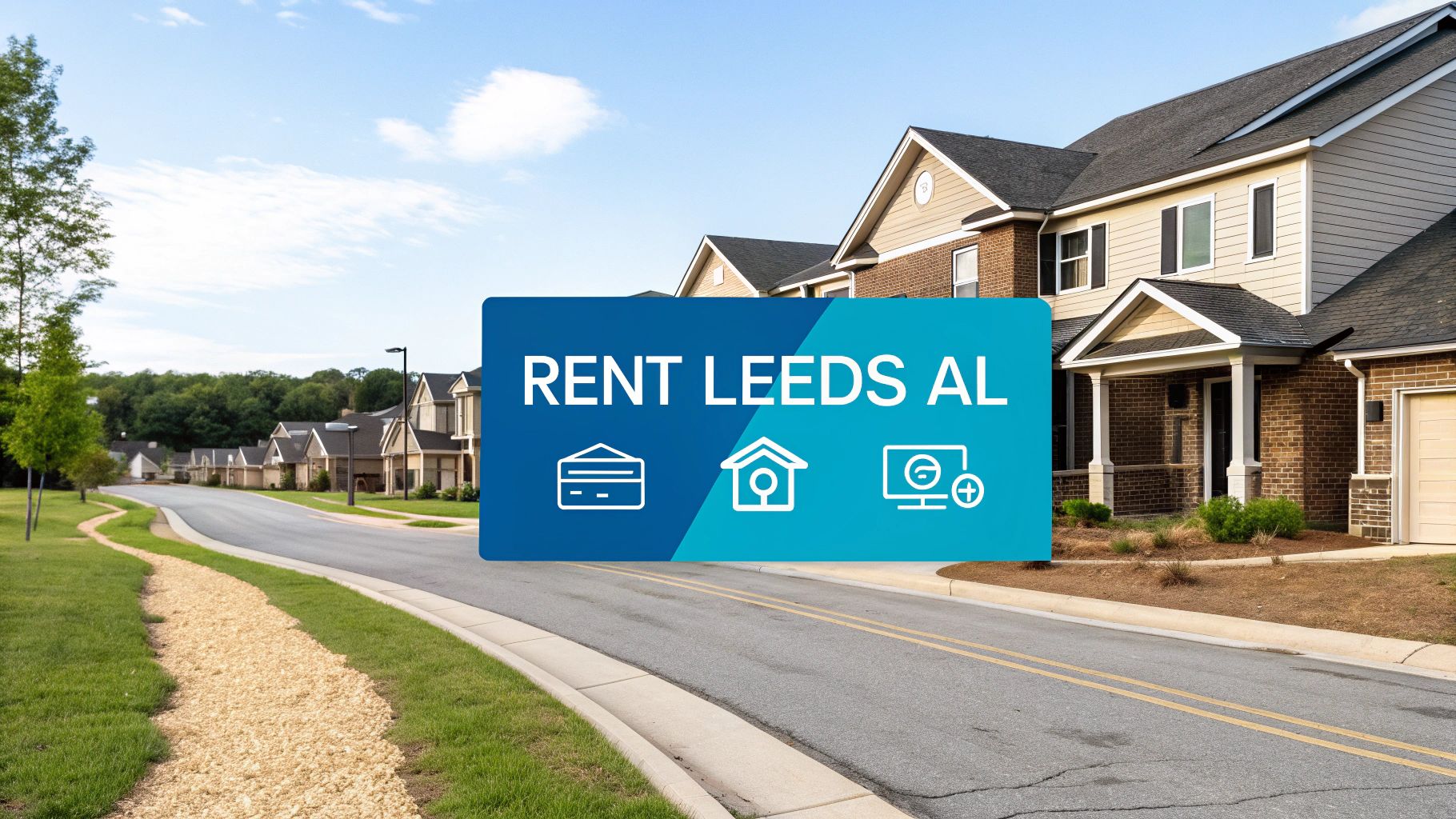If you’re managing a large portfolio, you’ve felt the pain of rising vacancy costs and operational gridlock. For property management companies scaling past 1,000 units, a standard tenant web access platform for collecting rent is no longer enough. To drive real revenue and optimize cost-per-door efficiency, this platform must become the central command for your entire remote leasing operation—the strategic leap from clunky spreadsheets to a fully integrated, scalable system.
Moving Beyond Spreadsheets to Scalable Systems
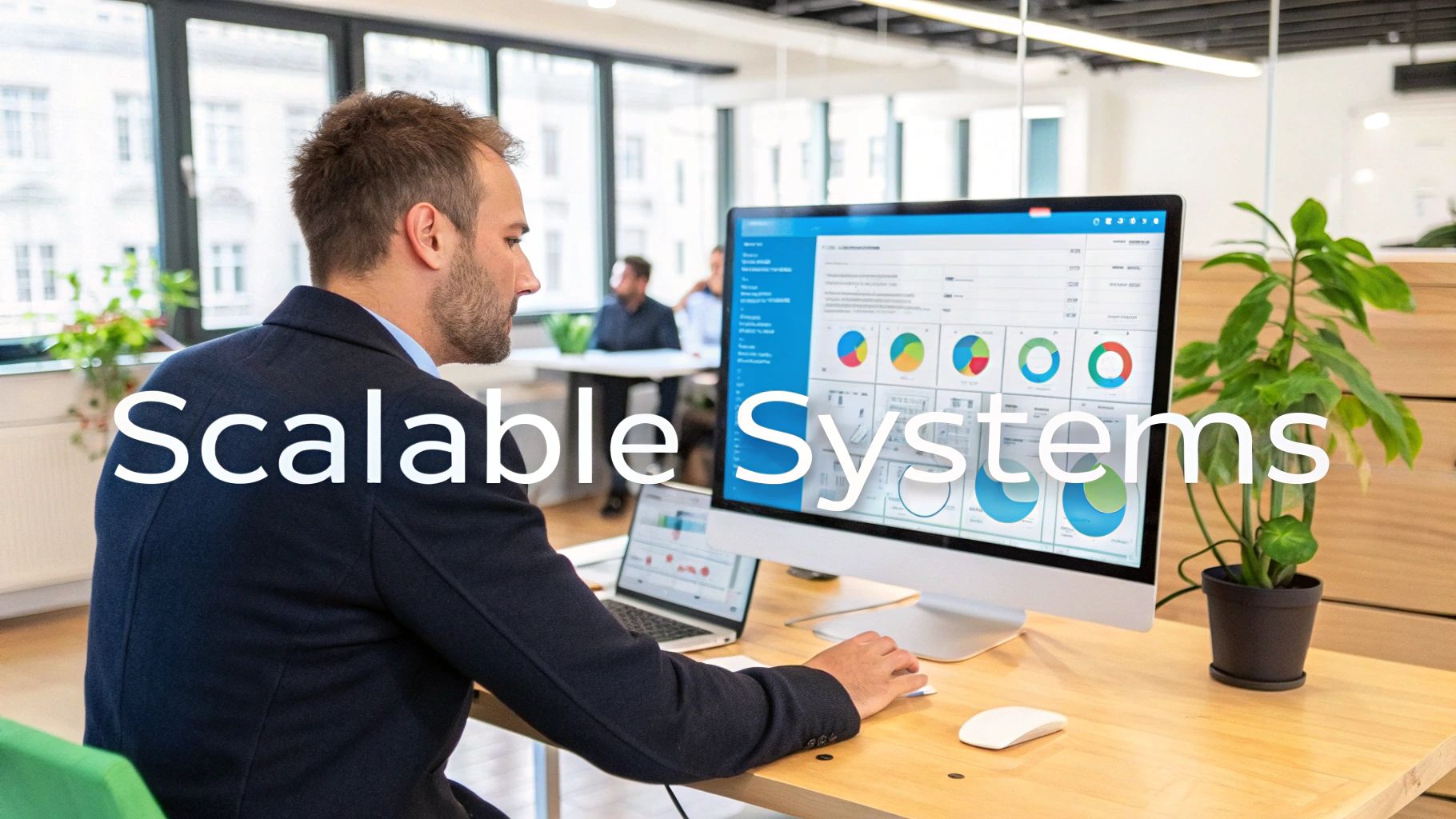
For most enterprise-level property management companies, "tenant web access" traditionally means online payments and maintenance tickets. This view is too small. It misses the platform's power to serve as the central nervous system for your entire leasing operation, directly impacting your most critical metric: Days on Market (DOM).
When you're managing a portfolio of 1,000+ units across multiple markets, manual processes and disconnected systems are a direct drain on revenue. Every administrative delay, from scheduling a tour to processing an application, adds to your DOM. Across a large portfolio, these delays compound rapidly, hitting your bottom line with staggering force. The solution isn't a better spreadsheet; it's a fundamental operational shift.
The Strategic Imperative of a Centralized Hub
A truly scalable tenant web access system is a centralized hub that integrates the entire leasing lifecycle. It's where lead generation, automated tour scheduling, application processing, and tenant communications converge into a seamless workflow. Mastering this is non-negotiable for operating efficiently at scale.
This isn't just about internal efficiency; it's about meeting market demand. Digital-native renters expect smooth, mobile-first experiences. As these demographics dominate the rental market, a superior digital journey isn't a perk—it's essential for competitive advantage. As you can discover more in this analysis of renter expectations, this shift reduces human error, automates low-value tasks, and creates the fast, seamless experience modern renters demand.
For a portfolio of 2,500 units with an average rent of $1,800, every single day a unit sits vacant costs the portfolio $150,000. Reducing DOM by just five days could recover $750,000 in annual revenue.
By treating tenant web access as a strategic imperative, large-scale operators can stop thinking about convenience and start unlocking its real power to:
- Drastically reduce DOM: Automate tour scheduling and follow-ups to convert hot leads into signed leases in record time.
- Optimize cost-per-door: Free up leasing teams from administrative tasks so they can focus on high-value, revenue-generating activities.
- Standardize processes: Ensure a consistent, professional experience for every prospect across a distributed portfolio, solidifying brand quality at scale.
This mindset transforms tenant web access from a simple feature into the core engine driving your portfolio's growth, financial performance, and ability to scale.
Core Features That Drive Operational Efficiency
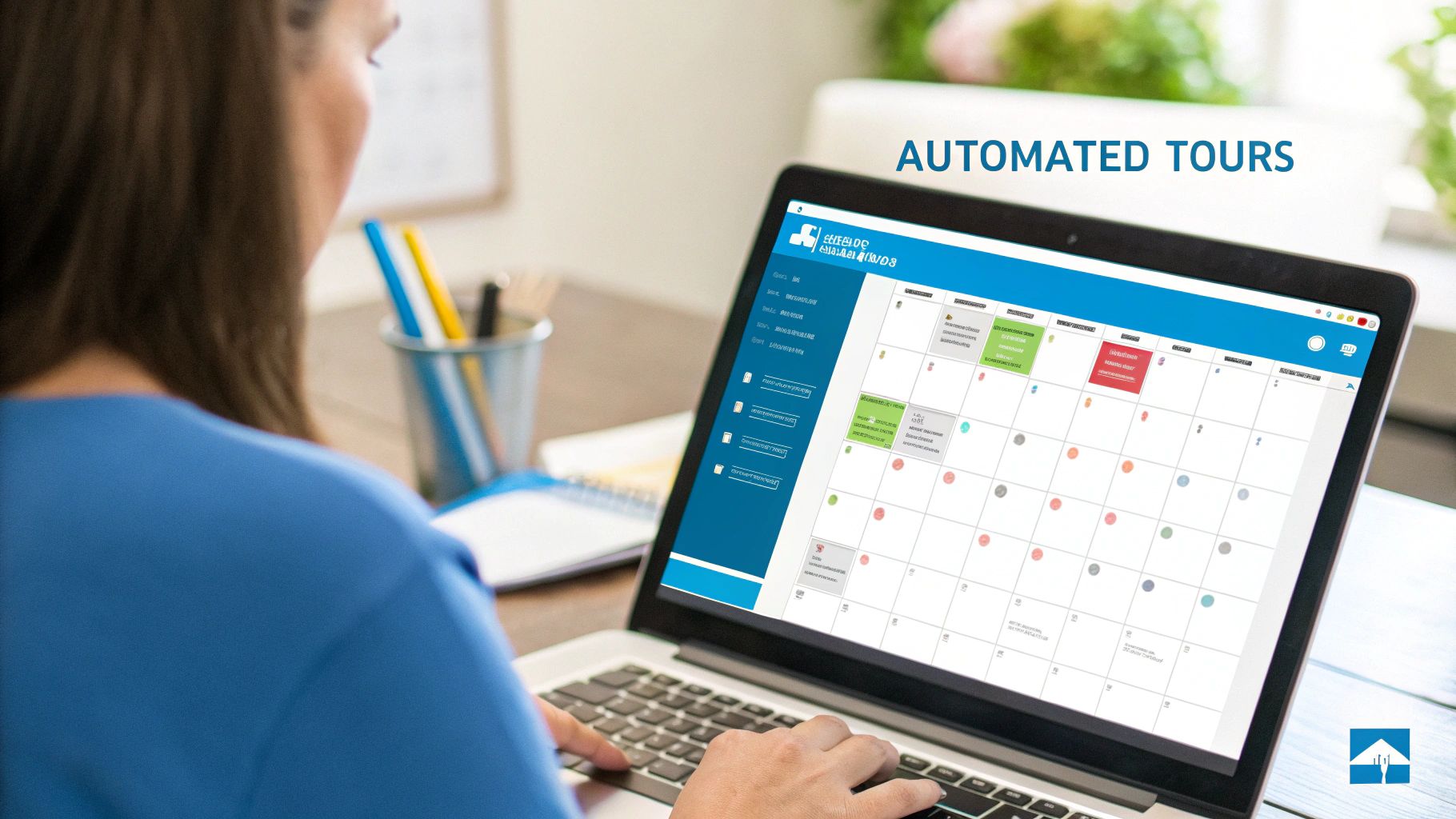
When managing a large portfolio, any new technology must connect directly to the key performance indicators (KPIs) that dictate profitability. An enterprise-grade tenant web access platform isn’t about convenience; it’s a powerful engine for operational excellence designed to solve the biggest challenges in remote property management.
The right features don't just feel modern—they generate measurable returns by compressing the leasing timeline and standardizing operations across thousands of units.
Automated Tour Scheduling
The biggest bottleneck in leasing is often the delay between a prospect expressing interest and actually seeing the property. Automated tour scheduling eliminates this bottleneck. Instead of back-and-forth emails, qualified leads can instantly book showings based on real-time availability, converting interest into action before a competitor can.
This feature is a direct assault on Days on Market (DOM). For a portfolio distributed across multiple cities, it means filling vacancies faster without needing onsite staff at every property. The entire lead-to-tour process is reduced from days to minutes, a critical advantage in a competitive market.
If you're wondering how to pick the right system, we've got a great guide on how to choose self showing software.
Secure Document Management
Managing applications, lease agreements, and compliance documents across a multi-market portfolio without a central system is a recipe for operational chaos. Secure document management provides a single source of truth, creating the process standardization essential for scaling.
This feature ensures every leasing agent, regardless of location, follows an identical, compliant process. It slashes errors, mitigates risk, and gives operations directors a clear view of the entire leasing pipeline. A robust system will also track critical compliance documents like landlord gas safety (CP12) certificates, creating a secure and auditable trail for every transaction—a must for quality control at scale.
Integrated Communication Hubs
Inefficient communication kills deals and erodes tenant satisfaction. An integrated communication hub centralizes every interaction—prospect inquiries, application updates, and current tenant messages—into one organized platform.
This cuts down on administrative drain by automating routine follow-ups and answering common questions instantly. More importantly, it creates a seamless, professional experience for both prospects and tenants, who receive timely, consistent updates at every stage.
Mini Case Study: A 5,000-unit property management company rolled out a tenant web access platform with an integrated communication hub. Within six months, they cut administrative response times by 40% and saw a 15% jump in positive tenant satisfaction scores. This new efficiency let them reallocate a full-time admin role to focus on revenue-generating activities.
By integrating these core features, a tenant web access system becomes the backbone of a lean, remote-first operation, directly improving your most important metrics.
How Key Features Impact Enterprise KPIs
For large-scale operators, it's crucial to see exactly how a feature translates into financial performance. This table breaks down the connection between core functionalities and the KPIs that matter most when you're managing 1,000+ units.
Ultimately, the goal is to shift your team's focus from reactive problem-solving to proactive portfolio optimization. That’s how modern property management companies achieve true scale.
Calculating the ROI of Your Tech Investment
For KPI-driven property managers, the financial impact is paramount. Adopting new technology is a calculated investment that must deliver a measurable return. The conversation about a powerful tenant web access platform must quickly move past features and focus on financial outcomes.
The key is to quantify the cost of inaction—specifically, the revenue lost to vacancy—and compare it against the gains from improved operational efficiency. The most critical metric in this calculation is your Days on Market (DOM). Every day a unit sits vacant represents a direct financial loss that multiplies across a large portfolio. A DOM Cost Analysis makes this loss tangible.
Running a DOM Cost Analysis
This analysis translates the abstract concept of "vacancy" into a hard dollar figure, creating a powerful business case for technology that accelerates the leasing cycle. The calculation is straightforward and exposes the high cost of slow, manual processes.
Here’s how to calculate your portfolio's daily vacancy cost:
Find Your Daily Rent: Take the average monthly rent across your properties and divide it by 30. If your average rent is $1,800/month, that comes out to $60 per unit, per day.
Get Your Daily Portfolio Cost: Multiply that daily rent by the total number of units you manage. For a 2,000-unit portfolio, that’s $60 x 2,000 = $120,000 per day. That's the full earning potential of your portfolio every single day.
Calculate Your Recovered Revenue: Now, just multiply that daily portfolio cost by the number of days you can realistically shave off your DOM.
Let's crunch the numbers: Imagine a 2,000-unit portfolio with an average rent of $1,500/month (that's $50/day). If you can reduce your DOM by just 5 days, you're talking about some serious money.
- Daily Portfolio Cost: $50/day x 2,000 units = $100,000
- Annual Revenue Recovered: $100,000 x 5 days = $500,000
The ROI is undeniable. A 5-day reduction in vacancy time isn't just an operational improvement; it's a half-million-dollar revenue recovery. This is the kind of hard data that makes investing in advanced tech like Showdigs a strategic imperative, as it’s purpose-built to slash DOM by automating the entire lead-to-tour journey.
Quantifying Labor and Operational Savings
Beyond recovering vacancy loss, a modern tenant web access system drives significant savings by automating repetitive, low-value tasks. Consider the hours your leasing agents spend on work that software can handle instantly:
- Scheduling Tours: Manually coordinating showings for a 1,000+ unit portfolio consumes thousands of hours annually in administrative back-and-forth. Automation reclaims that time.
- Answering Repetitive Questions: A system that provides instant answers to common prospect questions (e.g., "What is the pet policy?") eliminates countless daily interruptions.
- Following Up with Leads: Automated follow-up nurtures every prospect, boosting lead-to-tour conversion rates without manual intervention.
To quantify these savings, estimate the weekly hours your team spends on these tasks and multiply by their hourly wage. For large-scale operations, automation can equate to reclaiming one or more full-time employees, freeing up your team to focus on high-impact, revenue-generating activities like owner relations and new business development.
When you combine direct revenue recovery from DOM reduction with substantial labor cost savings, the business case becomes irrefutable.
Integrating Your Property Management Tech Stack
A standalone tenant web access platform, no matter how powerful, is an operational island. For property management companies managing over 1,000 units, true scalability comes from an interconnected tech ecosystem where data flows seamlessly between systems.
Without this integration, your team is burdened with manual data entry—a process that creates information silos, frustrates staff, and slows the leasing cycle to a crawl. Your core Property Management System (PMS) is the brain of your operation. Your leasing tools, including your tenant web access portal, are the sensory inputs. For the system to function effectively, information must flow between them instantly and accurately.
This is where API integrations become critical.
The Power of API Integrations
Application Programming Interfaces (APIs) are the secure bridges that connect your software, ensuring everyone operates from a single source of truth. When a unit's status is updated in your PMS, that change should be reflected on your tour scheduling platform in real-time. This real-time synchronization is the foundation of automation at scale.
For any tech-forward operations team, API integration is non-negotiable. It eliminates the costly human errors and bottlenecks that kill momentum and enables automated workflows capable of handling a 10,000-unit portfolio.
Here’s what that looks like in practice:
- Syncing Property Availability: A unit becomes available in your PMS. The API instantly pushes this update to your leasing platform, making it immediately available for tour scheduling.
- Automating Prospect Data Entry: A new lead inquires online. Their information is automatically created as a guest card in the PMS, ensuring data consistency without manual copy-pasting.
- Streamlining Lease Workflows: An e-lease is signed. The API triggers the next step in your PMS, such as initiating the tenant onboarding process or updating the unit's status to "leased."
Building a Cohesive Leasing Ecosystem
This level of integration shifts your team from reactive to proactive. Instead of manually reconciling data, they can focus on high-impact activities like optimizing lead conversion rates and reducing Days on Market (DOM).
The infrastructure supporting these interconnected services is expanding rapidly. The market for multi-tenant data centers, which power shared digital platforms, is projected to hit nearly USD 167.9 billion by 2033. This growth highlights the critical importance of interconnected systems for delivering seamless digital experiences at scale. You can learn more about these infrastructure trends and their impact.
An integrated system creates a virtuous cycle. Faster data flow leads to quicker tour scheduling, which reduces DOM. Reduced DOM increases revenue, providing a clear ROI on your technology investment.
A fully connected tech stack provides the unified data needed for strategic decision-making. By consolidating information from every stage of the leasing funnel, you gain a clear, holistic view of your portfolio's performance. You can track key metrics like lead-to-tour conversion rates by source, identify process bottlenecks, and make data-driven adjustments. For any company serious about scaling remote management, understanding your leasing platform integrations is the first step toward building a truly scalable and profitable operation.
A Framework for Portfolio-Wide Implementation
Rolling out new technology across a large, distributed portfolio requires a methodical, phase-by-phase approach to avoid operational disruption. For a tenant web access platform, a structured implementation plan mitigates risk, accelerates ROI, and ensures consistent adoption, which is especially critical when managing properties without onsite staff.
By breaking the rollout into manageable stages, you can refine workflows, gather field-level feedback, and build team buy-in before deploying across thousands of units. This isn't just about implementing software; it's about re-engineering your leasing operations for speed and scale.
The infographic below shows the simple, powerful data flow we're aiming for—syncing availability and prospect info to get that lease signed faster.
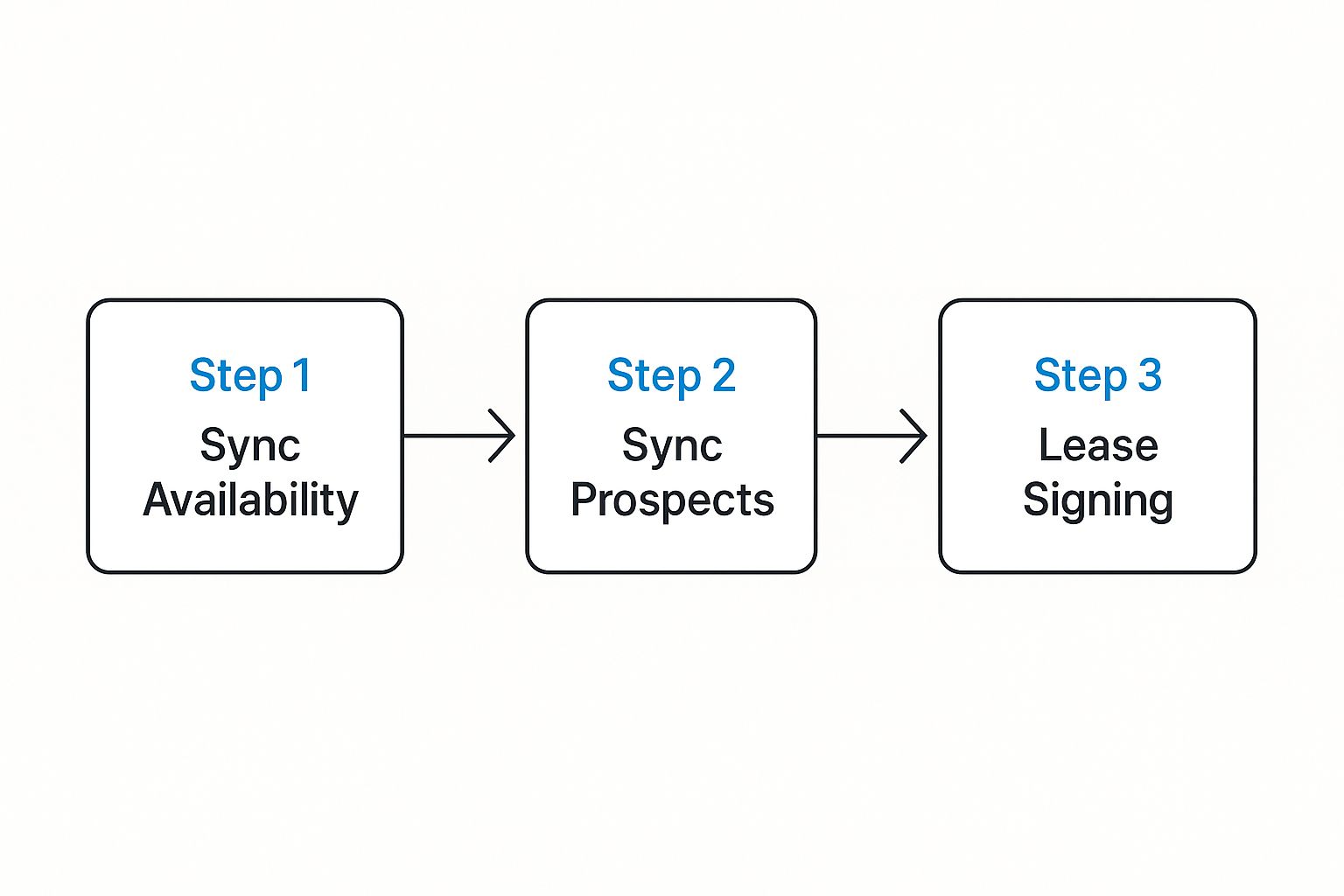
This represents an automated leasing journey that minimizes manual work and directly shrinks your time-to-lease.
Phase 1: System Configuration and Pilot Program
The first phase focuses on building a solid foundation. Before any user accesses the system, it must be configured to align with your existing workflows and integrated with your property management software via API. This stage involves setting up user roles, customizing communication templates, and establishing the data sync that will create a single source of truth.
Once configured, resist the urge to launch portfolio-wide. Instead, select a single market or a pilot group of 50-100 units. This controlled test allows you to:
- Validate Workflows: Identify and resolve any process friction before it impacts the entire portfolio.
- Gather Real-World Feedback: Collect insights from a small group of leasing agents to optimize the user experience.
- Establish Benchmarks: Measure baseline KPIs like lead response time and tour scheduling speed to quantify the platform's impact post-launch.
Phase 2: Staff Training and Process Documentation
With a validated workflow, the next phase is preparing your team for adoption. Create a comprehensive training program that includes live sessions, on-demand video tutorials, and quick-reference guides. The goal is standardization: a leasing agent in one market should operate identically to an agent a thousand miles away.
Develop a centralized knowledge base—a digital playbook—that documents every step of the new leasing process. This ensures consistency and accelerates the onboarding of new hires.
Phase 3: Full Portfolio Rollout and Performance Monitoring
With a tested system and a trained team, you are ready for a full launch. Execute the rollout market-by-market or in large segments, providing dedicated support during the transition period.
A successful rollout isn’t the finish line; it's the new starting line for continuous optimization. Post-launch, your focus must shift to performance monitoring.
Continuously track your key performance indicators (KPIs). Are you achieving the projected Days on Market (DOM) reduction? Has your lead-to-tour conversion rate improved? Use the platform’s analytics to identify high-performing markets and replicate their success strategies across the portfolio, ensuring your technology investment delivers maximum revenue and efficiency gains.
Enhancing the Tenant Experience to Boost Retention

As leasing operations become increasingly automated, sophisticated property managers recognize that tenant web access is evolving from a simple utility into the central hub for the entire resident lifecycle. This evolution is critical for the long-term financial health of any large portfolio.
The transactional tenant portal—a clunky website for rent payments and maintenance tickets—is obsolete. Today’s renters expect seamless digital experiences on par with the best consumer apps. A frustrating portal is no longer a minor inconvenience; it's a contributing factor to tenant turnover.
From Transactional Tool to Experience Platform
A modern tenant web access system must be the digital heartbeat of your community, offering value far beyond basic transactions. This approach fosters a stronger, more positive relationship with tenants, which directly translates into higher retention rates and reduced turnover costs.
This expectation for seamless digital interaction is universal. A recent global workplace survey found that clunky technology and outdated access systems were a major source of dissatisfaction for nearly 50% of office tenants. The message is clear: a superior digital experience is a key driver of tenant satisfaction across all property types.
Consider the financial impact. For a 3,000-unit portfolio, increasing tenant retention by just 5% can save over $250,000 annually in turnover costs (including lost rent, marketing, and make-ready expenses). A great digital experience is a direct investment in your bottom line.
Key Components of an Experience-Focused Platform
To meaningfully impact tenant experience and retention, your platform must enhance convenience and connection.
Here’s what that looks like in practice:
- Integrated Services: Allow residents to purchase renters' insurance, set up utilities, or access discounts for local services directly within the portal.
- Community Building: Use the platform as a digital community hub to announce events, share important building updates, or facilitate resident connections.
- Seamless Onboarding: Guide new tenants through a digital move-in checklist, from lease signing to key pickup, creating a welcoming and supportive experience from day one.
- Proactive Communication: Automate lease renewal reminders with personalized offers, making it easy for satisfied tenants to stay. A centralized Showdigs user account is a great example of how to keep these interactions organized and efficient.
Investing in a superior tenant web access platform does more than just fill units faster. It builds the foundation for long-term resident loyalty, slashes costly turnover, and maximizes the lifetime value of every renter in your portfolio.
Got Questions? We've Got Answers
Adopting a new platform across a large portfolio naturally raises questions. Here are answers to common inquiries from property managers considering an enterprise-level tenant web access solution.
How Is a Dedicated Platform Different from My Regular PMS Portal?
Your Property Management System (PMS) portal is designed for current resident management—primarily rent collection and maintenance. A dedicated leasing platform, however, is purpose-built to accelerate one process: converting leads into signed leases.
It offers specialized tools like on-demand tour scheduling, automated prospect follow-up, and detailed leasing analytics. These features are engineered to directly reduce your Days on Market (DOM) and lower your cost-per-door—functions that a standard PMS portal is not designed to optimize.
What’s a Realistic Timeline for a 1,000-Unit Portfolio?
For a distributed 1,000-unit portfolio, a phased rollout over 4 to 8 weeks is a realistic and effective timeline. This structured approach ensures a smooth transition and successful team adoption.
A typical implementation looks like this:
- Weeks 1-2: System configuration and API integration with your existing PMS.
- Weeks 3-5: Launch of a pilot program in a single market to validate workflows and gather feedback.
- Weeks 6-8: Full portfolio rollout, accompanied by comprehensive staff training and support.
How Do We Keep Our Data Secure When Plugging in a New Platform?
Data security is non-negotiable. Prioritize solutions that are SOC 2 compliant, as this certification provides third-party validation that the provider adheres to stringent security and privacy standards.
The integration itself should use secure, modern authentication like OAuth 2.0. This gives you tight control over what data gets shared, ensuring the platform only accesses what it needs—like unit availability or prospect info—without opening up your entire database. Always do a deep dive into a provider's security and privacy policies before you sign anything.
Ready to stop watching your Days on Market creep up? Showdigs gives you the AI-powered automation and on-demand agent network you need to sign leases faster and grow your portfolio without the growing pains.





